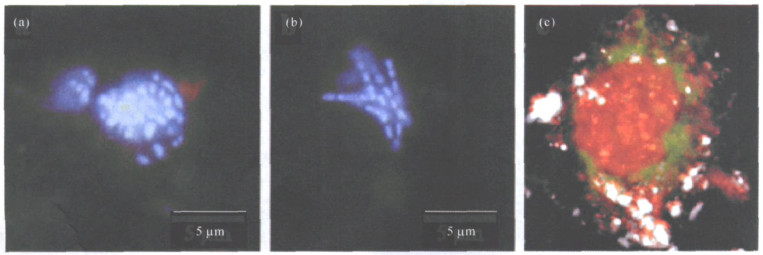|
Baross, J. A., Hoff man, S. E., 1985. Submarine hydrothermalvents and associated gradient environments as sites for the origin and evolution of life. Origins Life, 15: 327-345. |
|
Boetius, A., Suess, E., 2004. Hydrate ridge: A natural labo-ratory for the study of microbial life fueled by methane from near-surface gas hydrates. Chemical Geology, 205: 291-310. doi: 10.1016/j.chemgeo.2003.12.034 |
|
Bons, P. D., Montenari, M., Hartmann, D., et al., 2004. Fos-sil microbes in late Proterozoic fibrous calcite veins from Arkaroola, South Australia. In: Geological Society of America, 2004 annual meeting, Anonymous. Ab-stracts with Programs-Geological Society of America (November 2004), 36 (5): 475. |
|
Brasier, M. D., Green, O. R., Jephcoat, A. P., et al., 2002. Questioning the evidence for earth′s oldest fossils. Na-ture, 416: 76-81. |
|
Chen, J., Lian, B., Wang, B., et al., 2006. The occurrence and biogeochemistry of microbes in extreme environ-ments. Earth Science Frontiers, 13 (6): 199-207 (in Chinese with English abstract). |
|
Daffonchio1, D., Borin1, S., Brusa1, T., et al., 2006. Strati-fied prokaryote network in the oxic-anoxic transition of a deep-sea halocline. Nature, 440: 203-207. doi: 10.1038/nature04418 |
|
Dang, H. Y., Li, T. G., Zeng, Z. G., et al., 2006. Microbio-logical studies on sub-sea floor deep biosphere in deep sea extreme environments. Studia Marina Sinica, 47: 41-60 (in Chinese with English abstract). |
|
Deming, J. W., Baross, J. A., 1993. Deep-sea smokers: Win-dows to a sub-surface biosphere. Geochimicaet Cosmo-chimica Acta, 57: 3219-3229. doi: 10.1016/0016-7037(93)90535-5 |
|
Dutkiewicz, A., Volk, H., George, S., et al., 2006. Biomark-ers from Huronian oil-bearing fluid inclusions: An un-contaminated record of life before the Great Oxidation Event. Geology, 34 (6): 437-440. doi: 10.1130/G22360.1 |
|
Dutkiewicz, A., Volk, H., Ridley, J., et al., 2003. Biomark-ers, brines, and oil in the Mesoproterozoic, Roper Super-basin, Australia. Geology, 31 (11): 981-984. doi: 10.1130/G19754.1 |
|
Feng, J., Li, J. H., Niu, X. L., 2005. Research advances in hydrothermal vent microbial communities and its signif-icance for geology. Advances in Earth Science, 20 (7): 732-739 (in Chinese with English abstract). |
|
Fink, C. R., Spence, G. D., 1999. Hydrate distribution off Vancouver Island from multifrequency single-channel seismic reflection data. J. Geophys. Res. (Solid Earth), 104: 2909-2922. doi: 10.1029/98JB02641 |
|
Furnes, H., Banerjee, N. R., Muehlenbachs, K., et al., 2004. Early life recorded in archean pillow lavas. Science, 304 (5670): 578-581. doi: 10.1126/science.1095858 |
|
Hinrichs, K. U., Hayes, J. M., Sylva, S. P., et al., 1999. Methane-consuming archaebacteria in marine sedi-ments. Nature, 398 (6730): 802-805. doi: 10.1038/19751 |
|
Horita, J., Berndt, M. E., 1999. Abiogenic methane forma-tion and isotopic fractionation under hydrothermal con-ditions. Science, 285: 1055-1057. doi: 10.1126/science.285.5430.1055 |
|
Ian, M., Head, D., Martin, J., et al., 2003. Biological activityin the deep subsurface and the origin of heavy oil. Na-ture, 344-352. |
|
IPSC, 2001. Earth, oceans and life: Integrated ocean drilling program, initial science plan, 2003-2013. IWG Sup-porting Office, Washington DC, 110. |
|
Jiang, G. Q., Kennedy, M. J., Christie-Blick, N., 2003. Stableisotopic evidence for methane seeps in Neoproterozoic postglacial cap carbonates. Nature, 426: 822-826. doi: 10.1038/nature02201 |
|
Jiang, G. Q., Kennedy, M. J., Christie-Blick, N., et al., 2006. Stratigraphy, sedimentary structures, and textures of the late Neoproterozoic Doushantuo cap carbonate in South China. Journal of Sedimentary Research, 76: 978-995. doi: 10.2110/jsr.2006.086 |
|
Krajick, K., 2007. Race to plumb the frigid depths. Science, 315: 1525-1528. doi: 10.1126/science.315.5818.1525 |
|
Krejci-Graf, K., 1932. Rule of density of oils. Bull. Am. As-soc. Petrol. Geol. , 16: 1038. |
|
Kruglyakova, R. P., Byakov, Y. A., Kruglyakova, M. V., et al., 2004. Natural oil and gas seeps on the Black Sea floor. Geo-Mar. Lett. , 24: 150-162. |
|
Li, Q., Wang, J. S., Chen, Q., et al., 2006. Barite within the cap dolomite in Three Gorges area and its palaeogeo-graphic meaning. Journal of Northwest University (Natural Science Edition), 36 (special issue): 196-200 (in Chinese with English abstract). |
|
Li, Y. L., Peacock, A. D., White D. C., et al., 2007. Spatial patterns of bacterial signature biomarkers in marine sediments of the Gulf of Mexico. Chemical Geology, 238: 168-179. doi: 10.1016/j.chemgeo.2006.11.007 |
|
Liu, J. F., Mu, B. Z., 2004. Extreme environment of oil reser-voir and associated microorganisms. Journal of Micro-biology, 24 (4): 31-34 (in Chinese with English ab-stract). |
|
Lollar, S. B., Westgate, T. D., Ward, J. A., et al., 2002. Abiogenic formation of alkanes in the earth′s crust as a minor source for global hydrocarbon reservoirs. Na-ture, 416: 522-524. |
|
Margesin, R., Schinner, F., 2001. Biodegradation and biore-mediation of hydrocarbons in extreme environments. Appl. Microbiol. Biotechnol. , 56: 650-663. doi: 10.1007/s002530100701 |
|
Marsh, A. G., Mullineaux, L. S., Young, C. M., et al., 2001. Larval dispersal potential of the tubeworm Riftia pachy-ptila at deep-sea hydrothermal vents. Nature, 411: 77-80. doi: 10.1038/35075063 |
|
Nussbaumer, A. D., Fisher, C. R., Bright, M., 2006. Hori-zontal endosymbiont transmission in hydrothermal venttubeworms. Nature, 441: 345-348. doi: 10.1038/nature04793 |
|
Orphan, V. J., House, C. H., Hinrichs, K. U., et al., 2001. Methane-consuming archaea revealed by directly cou-pled isotopic and phylogenetic analysis. Science, 293 (5529): 484-487. doi: 10.1126/science.1061338 |
|
Orphan, V. J., House, C. H., Hinrichs, K. U., et al., 2002. Multiple archaeal groups mediate methane oxidation in anoxic cold seep sediments. Proceedings of the National Academy of Sciences of the United States of America, 99 (11): 7663-7668. doi: 10.1073/pnas.072210299 |
|
Parkes, R. J., Cragg, B. A., Wellsbury, P., 2000. Recentstudies on bacterial populations and processes in subseafloor sediments: A review. Hydrogeological Jour-nal, 8 (1): 11-28. doi: 10.1007/PL00010971 |
|
Paull, C. K., Hecker, B., Commeau, R., et al., 1984. Biologi-cal communities at the Florida escarpment resemble hy-drothermal vent taxa. Science, 226: 965-967. doi: 10.1126/science.226.4677.965 |
|
Paull, C. K., Schlining, B., Ussler Ⅲ, W., et al., 2005. Dis-tribution of chemosynthetic biological communities in Monterey Bay, California. Geology, 33 (2): 85-88. doi: 10.1130/G20927.1 |
|
Pradillon, F., Shillito, B., Young, C. M., et al., 2001. Devel-opmental arrest in vent worm embryos. Nature, 413: 698-699. doi: 10.1038/35099674 |
|
Prieur, D., 1997. Microbiology of deep-sea hydrothermalvents. Marine Biotechnology, 15: 42-244. |
|
Rasmussen, B., 2005. Evidence for pervasive petroleum gen-eration and migration in 3.2 and 2.63 Ga shales. Geolo-gy, 497-500. |
|
Rasmussen, B., Buick, R., 2000. Oil old ores: Evidence for hydrothermal petroleum generation in an Archean vol-canogenic massive sulfide deposit. Geology, 731-734. |
|
Rothschild, L. J., Mancinelli, R. L., 2001. Life in extreme en-vironments. Nature, 409: 1092-1101. doi: 10.1038/35059215 |
|
Rusanov, I. I., Lein, A. Y., Pi menov, N. V., et al., 2002. The biogeochemical cycles of methane on the northwesternshelf of the Black Sea. Microbiology, 71 (4): 479-487. doi: 10.1023/A:1019862014508 |
|
Science Committee of ODP China, 2003. Chinese national sci-ence plan (2003-2013) for participation in IODP. Ad-vances in Earth Science, 18 (5): 662-665 (in Chinese with English abstract). |
|
Seewald, J. S., 2003. Organic-inorganic interactions in petro-leum-producing sedimentary basins. Nature, 426: 327-333. doi: 10.1038/nature02132 |
|
Si moneit, B. R. T., Lonsdale, P. F., 1982. Hydrothermal pe-troleum in mineralized mounds at the seabed of Guay-mas basin. Nature, 295: 198-202. doi: 10.1038/295198a0 |
|
Su, X., Chen, F., Wei, S. P., et al., 2007. Preliminary study on the correlation between microbial abundance and methane concentration in sediments from cold seeps in the northern South China Sea. Geoscience, 21 (1): 101-104 (in Chinese with English abstract). |
|
Takai, K., Gamo, T., Tsunogai, U., et al., 2004. Geochemi-cal and microbiological evidence for a hydrogen-based, hyperthermophilic subsurface lithoautotrophic microbial ecosystem (HyperSLME) beneath an active deep-sea hydrothermal field. Extremophiles, 8 (4): 269-282. doi: 10.1007/s00792-004-0386-3 |
|
Tarasov, V. G., Gebruk, A. V., Mironov, A. N., et al., 2005. Deep-sea and shallow-water hydrothermal ventcommunities: Two different phenomena? Chemical Ge-ology, 224: 5-39. |
|
Wang, J. S., Gan, H. Y., Wei, Q., et al., 2005. Stable iso-topes of carbon and sulfur of cap dolomite in the Three Gorges and its mechanism discussion. Geoscience, 19 (1): 14-20 (in Chinese with English abstract). |
|
Wang, P. X., 2003. Earth system science in China Quo Va-dis? Advances in Earth Science, 18 (6): 837-851 (in Chinese with English abstract). |
|
Wang, W. C., Tao, M. X., 2005. Geomicrobial processes and petroleum resources. Geological Bulletin of China, 24 (10-11): 1022-1026 (in Chinese with English ab-stract). |
|
Wilhel ms, A., Larter, S. R., Head, I., et al., 2001. Biodegra-dation of oil in uplifted basins prevented by deep-burial sterilization. Nature, 411: 1034-1037. doi: 10.1038/35082535 |
|
Wilson, H. H., 1990. The case for early generation and accu-mulation of oil. Journal of Petroleum Geology, 13 (2): 127-156. doi: 10.1111/j.1747-5457.1990.tb00836.x |
|
Yang, R. D., Zhu, L. J., Gao, H., et al., 2005. A study on characteristics of the hydrothermal vent and relating bi-ota at the Cambrian bottom in Songlin, Zunyi County, Guizhou Province. Geological Review, 51 (5): 481-492 (in Chinese with English abstract). |
|
You, C. F., Bickle, M. J., 1998. Evolution of an active sea-floor massive sulphide deposit. Nature, 394: 668-671. doi: 10.1038/29279 |
|
Zhang, C. L., Lanoil, B., 2004. Geomicrobiology and biogeo-chemistry of gas hydrates and cold seeps. Chemical Ge-ology, 205 (3-4): 187-194. |
|
Zhang, M., Dong, X. Z., 2006. A survey of extromophiles project supported by 973. Acta Microbiologica Sinica, 46 (2): 336 (in Chinese). |
|
Zhou, Q., Du, Y. S., Wang, J. S., et al., 2007. The character-istics and significance of the cold seep carbonates from Datangpo Formation, Nanhua Serise in the northeast of Guizhou. Earth Science—Journal of China University of Geoscicenes, 32 (3): 339-346 (in Chinese with Eng-lish abstract). |
|
陈骏, 连宾, 王斌, 等, 2006. 极端环境下的微生物及其生物地球化学作用. 地学前缘, 13 (6): 199-207. doi: 10.3321/j.issn:1005-2321.2006.06.023 |
|
党宏月, 李铁刚, 曾志刚, 等, 2006. 深海极端环境深部生物圈微生物学研究综述. 海洋科学集刊, 47: 41-60. https://www.cnki.com.cn/Article/CJFDTOTAL-HKJK200600003.htm |
|
冯军, 李江海, 牛向龙, 2005. 现代海底热液微生物群落及其地质意义. 地球科学进展, 20 (7): 732-739. doi: 10.3321/j.issn:1001-8166.2005.07.005 |
|
李清, 王家生, 陈祈, 等, 2006. 三峡"盖帽"白云岩中重晶石研究及其古地理意义. 西北大学学报(自然科学版), 36 (专辑): 196-200. |
|
刘金峰, 牟伯中, 2004. 油藏极端环境中的微生物. 微生物学杂志, 24 (4): 31-34. doi: 10.3969/j.issn.1005-7021.2004.04.011 |
|
苏新, 陈芳, 魏士平, 等, 2007. 南海北部冷泉区沉积物中微生物丰度与甲烷浓度变化关系的初步研究. 现代地质, 21 (1): 101-104. doi: 10.3969/j.issn.1000-8527.2007.01.012 |
|
王家生, 甘华阳, 魏清, 等, 2005. 三峡"盖帽"白云岩的碳、硫稳定同位素研究及其成因探讨. 现代地质, 19 (1): 14-20. doi: 10.3969/j.issn.1000-8527.2005.01.002 |
|
汪品先, 2003. 我国的地球系统科学研究向何处去. 地球科学进展, 18 (6): 837-851. doi: 10.3321/j.issn:1001-8166.2003.06.003 |
|
王万春, 陶明信, 2005. 地质微生物作用与油气资源. 地质通报, 24 (10-11): 1022-1026. https://www.cnki.com.cn/Article/CJFDTOTAL-ZQYD2005Z1026.htm |
|
杨瑞东, 朱立军, 高慧, 等, 2005. 贵州遵义松林寒武系底部热液喷口及与喷口相关生物群特征. 地质论评, 51 (5): 481-492. doi: 10.3321/j.issn:0371-5736.2005.05.001 |
|
张敏, 东秀珠, 2006.973项目"极端微生物及其功能利用的基础研究"研究进展. 微生物学报, 46 (2): 336. doi: 10.3321/j.issn:0001-6209.2006.02.035 |
|
中国大洋钻探学术委员会, 2003. 中国加入综合大洋钻探(IODP) 科学计划(2003-2013). 地球科学进展, 18 (5): 662-665. doi: 10.3321/j.issn:1001-8166.2003.05.004 |
|
周琦, 杜远生, 王家生等, 2007. 黔东北地区南华系大塘坡组冷泉碳酸盐岩及其意义. 地球科学——中国地质大学学报, 32 (3): 339-346. https://www.cnki.com.cn/Article/CJFDTOTAL-DQKX200703005.htm |










 下载:
下载:

